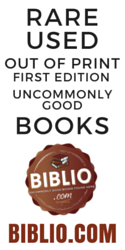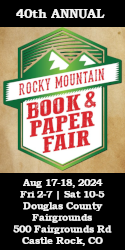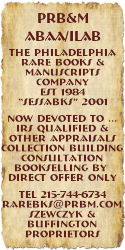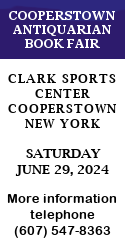Reference Is Not a Verb
The economics of reference book publishing has been under attack for some time, and even though many veteran booksellers have collections of what we used to think of as indispensable tools of the trade, the trend is to opt for electronic format. Large chunks of ABPC remain available on a memory stick that will connect to your computer with a simple USB connection (now, itself, considered “old” media mostly superseded by the online version that is updated monthly) – my own cloth-bound set running through 2004 still sits on a shelf near my desk. There are plenty of other online reference sources also, varying greatly in reliability – and the new/old adage that the Internet is a jungle has become a truism. But the interesting thing about truisms is that many of them tend to be true.
So even though I don’t buy reference books the way I used to, I was intrigued by Allen and Patricia Ahearn’s latest (4th) edition of Collected Books. The Guide to Identification and Values. (Comus, Quill & Brush, 2011). Most of the nearly 800 pages are devoted to updated pricing information on the more than 20,00 entries, along with useful bibliographical details as an aid to identifying various editions, issues and states, but it is the first 54 pages and the appendices alone that make it worth the $75.00 price for anyone thinking about starting a book collection.
Collected Books is not a substitute for a reference library (BAL, Howes, Wright, Soho Bibliographies, etc.), but an indispensable single-volume guide that will help beginning collectors sort through some of the bibliographical misinformation found on the Internet . (Only this week a caller offered to sell me a “genuine autographed first edition” of the Personal Memoirs of Ulysses S. Grant he’d bought online. It was published by William S. Konecky, the ISBN number appeared prominently in the preliminary pages, and his high three figure asking price was firm). I gently suggested that if he would check a little further he’d find similar reprints available for $1.00 (plus shipping and handling).
So what, some of you might think. It’s really only the words that matter. Fair enough, if they really are the author’s words, printed as intended. Ray Bradbury had something to say about this in a later edition of Fahrenheit 451: (as quoted in Collected Books)
Some five years back, the editors of yet another anthology for school readers put together a volume with 400 (count ‘em) short stories in it. How do you cram 400 short stories by Twain, Irving, Poe... into one book? Simplicity itself. Skin, debone, demarrow, scarify, melt, render down and destroy...
Every story, slenderized, starved, blue-penciled, leeched and bled white, resembled every other story. Only six weeks ago, I discovered that, over the years, some cubby-hole editors at Ballantine Books, fearful of contaminating the young, had, bit by bit, censored some 75 separate sections from the novel [Fahrenheit 451]. All you umpires, back to the bleachers. Referees, hit the showers. It’s my game, I pitch, I hit, I catch, I run the bases...
And no one can help me. Not even you.
To be fair, most revised or new editions (mainly non-fiction) reflect changes or corrections made by writers and editors, and are obviously desirable for that reason alone. However, highly edited or bowdlerized reprints of the sort of literary work mentioned by Bradbury, generally weaken or destroy the writer’s original intent. I have several editions of Fahrenheit, including an inscribed copy of the 40th Anniversary edition Mr. Bradbury sent to me some years ago, and am still on the prowl for some of the earlier editions (excepting the one in asbestos boards).
In addition to the pricing information and bibliographical detail comprising the main part of Collected Books, there are three appendices including [A] a glossary of terms, [B] a bibliography of bibliographies (or sources consulted) and [C] a guide to first edition identification according to publishers’ statements.
The preliminary 54 pages cover such topics as collecting options (author and/or subject); a discussion of editions, printings, issues, etc.; sources for books (catalogs, auctions, bookstores, internet); general book care; and things to consider when buying, selling or insuring your books.
All this business about collecting begs the question. Why do people collect books, or anything else for that matter. A hundred years ago it was quite fashionable, among the wealthier classes, to furnish a home with an impressive and well-stocked library. Whether the books were selected by others and seldom or never read, while sad, didn’t represent a complete loss – at least they were cared for until they were ultimately resold or given to other people who would either read them or repeat the process. And someday when reader/collectors rediscover some of the now-neglected 19th century writers, he or she may be grateful to the anonymous book-collectors of the past who, in reality, only held their books in trust.
From my own experience I suspect many present-day book collectors are squirrels at heart. Some of us buy books systematically, according to our interests – others in a more desultory fashion. In the second case, the books are frequently read and then passed along to friends or donated to a local library sale. One person we know is a member of at least one book club, yet when you visit his home there’s hardly a book to be seen – no library, no bookshelves in plain sight, no hint at all that he’s a serious reader. I suspect his reading and book-buying proceed in a measured and tandem fashion and then the books disappear like last week’s newspapers. For him, electronic readers would be enough.
And then others have a habit of buying and keeping more books than they can possibly read in the near term, medium term, long term, or several lifetimes, but somewhere in the process, assuming some vestiges of reason remain, they concentrate their efforts on one or more writers or subjects. At that point they become systematic collectors by default and, whether they know it or not, are in need of a basic reference work or bibliographical guide to help them avoid embarrassing (and sometimes expensive) mistakes, such as the one made by the overly-enthusiastic owner of an “autographed first edition” of the Personal Memoirs of Ulysses S. Grant.
*
The verbing of nouns is a contemporary trend not without precedent. Hammer is both noun and verb – I use a hammer but I also hammer nails into wood. We hammer nails, drive nails, pound nails, and sometimes get hammered. We’ve gotten used to the verbing of this noun. Or did we noun the verb? Which came first? My OED doesn’t give a clear answer – the word has been used both ways since at least the 15th century.
Or maybe you’d prefer I say utilized? Have you noticed that almost no one uses anything these days? They utilize it and local television announcers and sales people are among the major offenders. Aside from making my teeth itch and what little hair I have left hurt, it’s a case of misuse (also both a noun and a verb). Charles Gould and I talked about this the other day and he came up with a clear and clever distinction. We use something for the purpose for which it was intended – we utilize something for a purpose for which it was not originally intended. We generally use a hammer to drive nails but we could utilize a shoe or a rock. Or to put it another way, we would probably use a hammer and saw to build bookshelves – or we could utilize a Swiss army knife.
In any case, not all nouns verb well. In my description of Collected Books, I was referring to a reference book, not referencing a refer book.
*
With some encouragement from Pamela Grath (Dog Ears Books) of Northport, Michigan and a few other bookseller/bibliophiles who also love messing about in the garden, I’ve decided to risk boring the rest of you by continuing to add a few personal paragraphs at the end of my column. However, it could be worse – it could be golf.
After a slow start to the season, because of a cool and rainy spring and early summer, we now have very hot and drought-like conditions that, in turn, may become completely reversed by the time you read this. The grass is turning brown and most of the vegetables are at least a week behind. The strawberries were the best in years and despite the local deer and rabbit infestation (mostly controlled by an excellent product called Liquid Fence, made from garlic and putrescent egg solids) we dined on asparagus three or four times a week from early May until the 4th of July, by which time we were thoroughly sick of it. Except for what we put in the freezer, no more asparagus for us until next spring. Also, three different kinds of lettuce, egg plants, tomatoes, winter and summer squash, several varieties of sweet and hot peppers, and other things too boring to mention. And so it goes in the vegetable patch.
My experience with ranunculus was somewhat underwhelming. The rose-like flowers were as attractive as promised, but unlike tulips, daffodils, and all kinds of lilies that keep their foliage for a little while, at least, the ranunculus plants began to wilt and turn brown even while in flower. I cut them off close to the ground and will wait to see if they grow and bloom again in the fall. In any event I’ll just leave them in place and not care very much if they fail to survive the winter.
Most of our Asiatic hybrid lilies are now faded with the exception of a very tall trumpet-flowered variety called Golden Temple. It has the aroma of the oriental hybrids (Mona Lisa, Star Gazer, etc.) with large, mostly pale yellow, tinged with russet, flowers. When it comes time to divide them, we should have a few bulbs to give away.
The dahlias are late this year – the first to come into bloom (in mid-July) were Lucky Number and Mystery Day, both “dinner plate” varieties with medium sized flowers averaging only six inches in diameter, followed a week later by my favorite, a cactus-flowered variety called New Dimension.

























